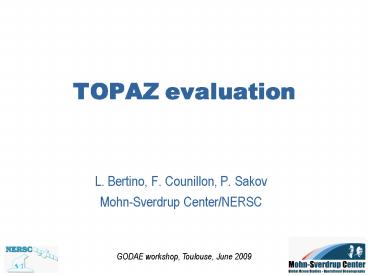TOPAZ evaluation - PowerPoint PPT Presentation
Title:
TOPAZ evaluation
Description:
TOPAZ evaluation. L. Bertino, F. Counillon, P. Sakov. Mohn-Sverdrup Center/NERSC ... The TOPAZ model system. TOPAZ3: Atlantic and Arctic. HYCOM EVP sea-ice model ... – PowerPoint PPT presentation
Number of Views:82
Avg rating:3.0/5.0
Title: TOPAZ evaluation
1
TOPAZ evaluation
- L. Bertino, F. Counillon, P. Sakov
- Mohn-Sverdrup Center/NERSC
GODAE workshop, Toulouse, June 2009
2
(No Transcript)
3
TOPAZ System overview
- System description
- Validation of TOPAZ
- Data Assimilation
4
Atmospheric Data
Satellite Data SLA, SST, Ice, In Situ Data
Sea-Ice model
Atlantic and Arctic model
EnKF Data assimilation system
Gulf of Mexico model
Eco- system model
Uncertainty estimates
Hindcast studies
User-targeted ocean forecasting
Ocean Primary production
Analyze the ocean circulation, sea-ice and
biogeochemistry. Provide real-time forecasts to
the general public and industrial users
5
The TOPAZ model system
- TOPAZ3 Atlantic and Arctic
- HYCOM EVP sea-ice model
- 11- 16 km horizontal resolution
- 22 hybrid layers
- EnKF
- 100 members
- Observations
- Sea Level Anomalies (CLS)
- Sea Surface Temperatures (NOAA)
- Sea Ice Concentr. (AMSR, NSIDC)
- Sea ice drift (CERSAT)
- Argo T/S profiles (Coriolis)
- Runs weekly, 10 days forecasts
- ECMWF forcing
- http//topaz.nersc.no/thredds
- http//thredds.met.no (MERSEA)
6
EnKF Correlations
3rd Jan 2006
8th Nov 2006
7
The HYCOM model
- 3D numerical ocean model
- Hybrid Coordinate Ocean model, HYCOM (U. Miami)
- US Navy global forecasts
- Hybrid coordinate
- Isopycnal in the interior
- Z-coordinate at the surface
- Terrain following (sigma)
- Nesting capability
- Coupled
- Sea-ice model
- Ecosystem models
- Large community (http//www.hycom.org)
8
Nesting
- Bring dynamically consistent information from
large-scale circulation to coastal seas - One-way nesting
- Flather condition for barotropic mode
- Avoids reflection of waves at the boundary
- Simple relaxation for the baroclinic mode
- And for the tracers
- Arbitrary resolution and orientation of the
nested grids
9
Effect of the upgradeWeekly SSS in Dec. 1999,
free run
MICOM BCM
TOPAZ3
TOPAZ4
10
TOPAZ System overview
- System description
- Validation
- Data Assimilation
11
3 Validation criteriacf weather forecasting
(Murphy, 93)
- Consistency
- Are the operational forecasts in agreement with
known processes of the ocean circulation? - Accuracy
- How close to reality are the results?
- Performance (value)
- Advantage over any trivial forecast?
- climatology, persistence
12
Validation Metrics
- Problems
- Validating and comparing GODAE systems
consistently - Different model horizontal grids / Vertical
coordinates - Large amounts of 4D data
- Large data transfers
- Solutions adopted (during Mersea Strand 1,
2003-2004) - 4 Classes of output products (3D, 2D, time
series, residuals) - Common output grids (1/8th deg, projection...)
- Self-documented file format (NetCDF)
- Inter-operable file access (OPeNDAP/THREDDS)
13
Arctic Metrics
14
Validation against hydrographic data
June07
Sept07
Topaz2
Topaz3
IMR
15
Online comparison to Argo profiles
16
Sparse profiles under iceNPEO deployment 2006
--- TOPAZ NPEO
North Pole Environment Observatory
17
Water fluxes
18
Sea-ice edgeVisual comparison
- Ice concentration from model in color, SSMI 15
ice contour in black. Ice drift is overlaid. - Good overall correspondence between model and
data - Visual comparison allows identification of
problematic regions - West of Novaya Zemlya - a tendency for the ice
edge to drift too little to the north during a
forecast cycle - South of Svalbard (Bear Island) model ice edge
too far to the north - Issues related to model physics
- Ice-ocean momentum exchange
- Ice models neglect physics which may be important
on small scales - Fast ice
- MIZ
19
Forecast skills by region
Barents Sea
Alaska
Bering Strait
Central Arctic
Greenland Sea
Kara Sea
20
SLA assimilation residualsAzores box
21
MERSEA sections updated
- Blue MERSEA Class2 sections
- Red Sections from IMR
22
TOPAZ System overview
- System description
- Validation
- Data Assimilation
23
Assimilation of Ocean Color in HYCOM-NORWECOM
- Data
- Satellite Ocean Color (SeaWIFS)
- Coupled Model
- HYCOM-NORWECOM
- (7 compartments)
- Problems
- Coupled 3-dimensional
- physical-biological model.
- High-dimension.
- Non-Gaussian variables.
- Perspectives
- Environment monitoring.
- Fisheries.
- Methodological developments
- for future coastal HR systems.
24
Gaussian anamorphosis with the EnKF
Anamorphosis prior transformation of the
variables in a Gaussian space (Bertino et al.
2003) Twin experiments (surface chlorophyll-a
synthetic observations)
Surface CHLa RMS error
EnKF Cut-off of neg. values
Gaussian Anamorphosis EnKF
Simon Bertino (OSD, 2009)































